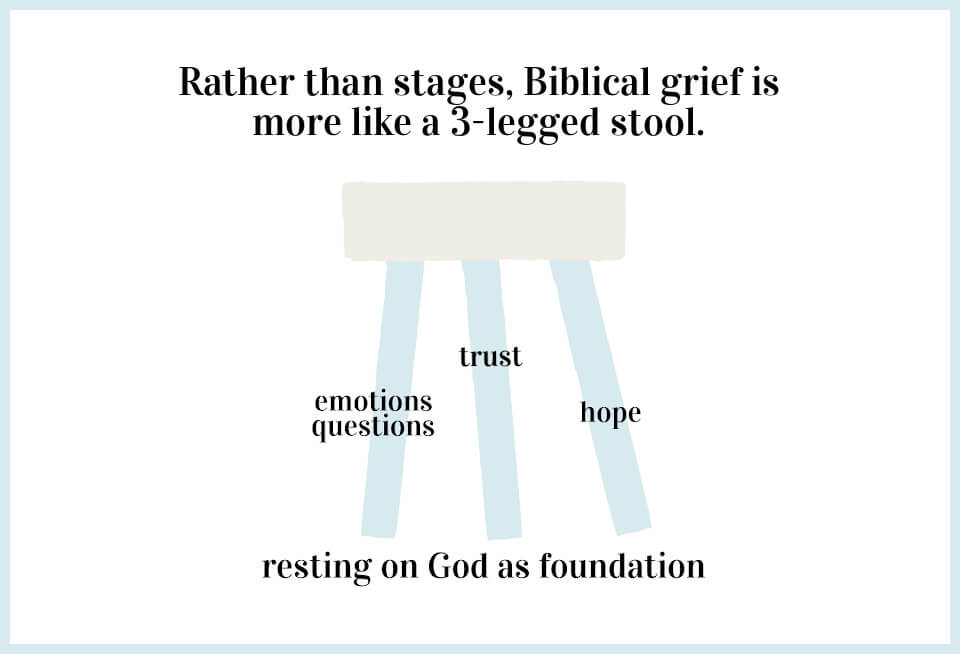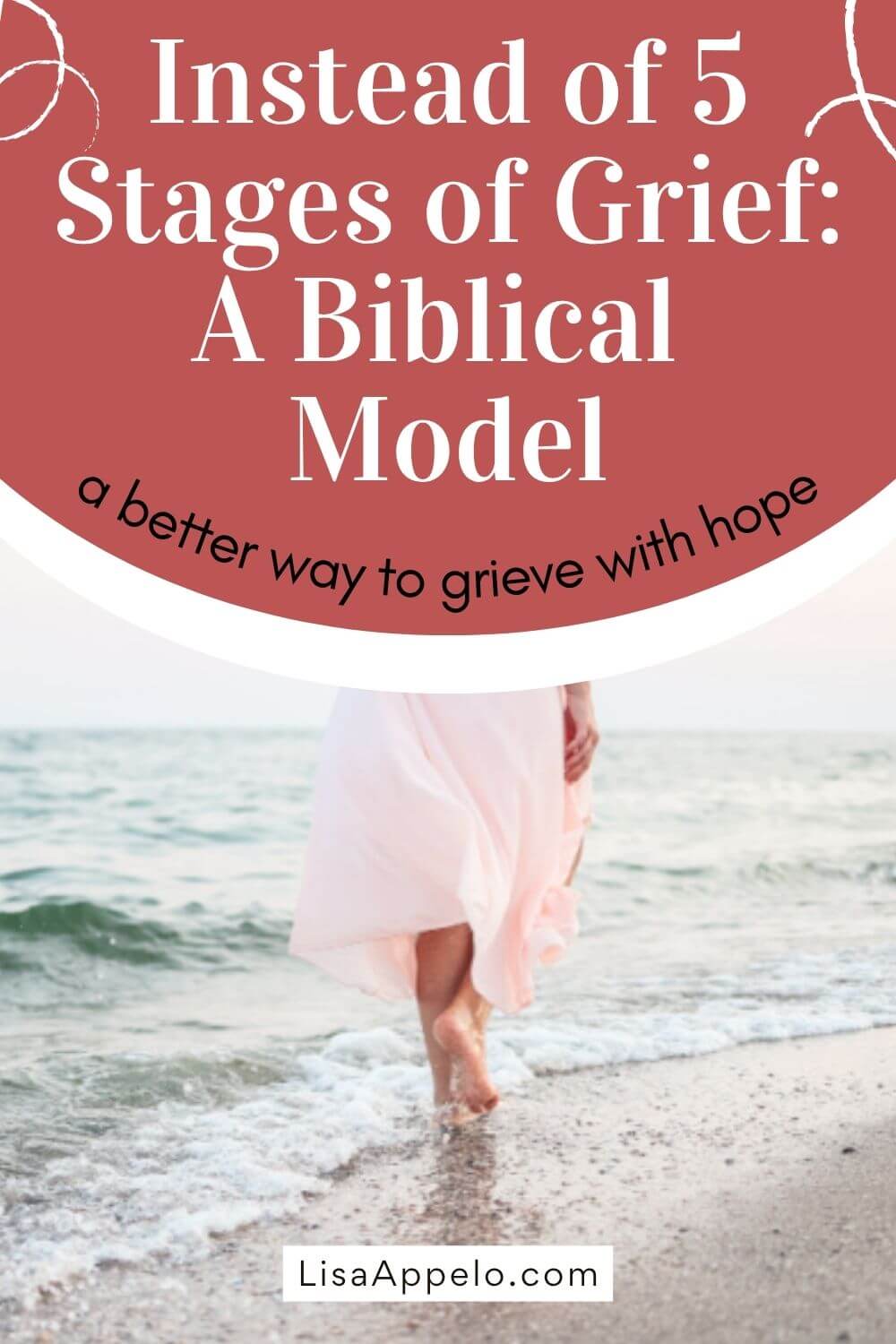
We are a grief illiterate culture. While we have reams of books, classes, and hand-me-down advice prepping us to welcome a new life into the world, we have little that readies us for the sorrow of life after a loss.
I knew very little about grief when I found myself smack dab in the middle of it.
One of the only mantras I’d heard about grief was the five stages of grief. I imagined mourning would be a line going up and to the right. If only I could make it through each stage, checking off each one, and get through all of our firsts (the birthdays, holidays, milestone days), I’d be okay.
Only this model didn’t hold up for me in practice. In fact, not one person I’ve talked to, counseled, or walked with in grief has experienced “five stages.”
The 5 stages of grief model
The five stages of grief paradigm—anger, denial, bargaining, depression, and acceptance—has become an embedded cultural presumption about the nature of grief. I get a daily news alert for grief articles across the nation and “5 stages of grief” is ubiquitous in headlines and media. Commentators apply it to everything from grief experienced after tragedies like child loss to a disappointing year for your football team.
The five stages were introduced in 1969 by Swedish pyschiatrist Dr. Kubler-Ross after interviewing dying patients, not those grieving someone who died. Kubler-Ross stated the five stages were “solely inspired” by the work of Sigmund Freud’s daughter, Anna Freud, in The Ego and The Mechanisms of Defense. While Dr. Kubler-Ross tempered the five concrete stages in subsequent work, the template had already taken on a life of its own, becoming entrenched in popular culture. The 5-stage model is embedded in school curriculum; movie and television tropes; music and gaming; and hospice and bereavement care.
The problems with 5 stages of grief
1. Grief isn’t linear. Mourning isn’t not a tidy progression of sequential phases we move through. I found grief to be a messy mix of multiple emotions, some conflicting, that we cycle through over and over. “The fact is, no study of grief has ever established that stages of grief actually exist…”
2. Everyone grieves differently. To presume everyone experiences five stages in loss is one-dimensional and inaccurate. I never experienced anger, for example. I kept expecting it because the 5-stage theory claimed it was universally part of grief. When I finally knew enough about grief to realize that each of us grieves differently, I was relieved I might at least be spared from anger.
3. Grief is more complicated than five tidy stages. Our grief response depends on an enormous range of physical, emotion, biological, mental, relational, circumstantial, and spiritual factors that don’t follow a prescriptive order. Grief shows us physically in our sleeping, eating, energy level, immune system, stress response, and more. It manifests mentally creating a griefy “brain fog” and affects our memory, focus, decisionmaking, and more.
4. Grief is more than grieving someone who died. The five stages are based solely on research of terminally ill patients and didn’t include anyone grieving the death of a loved one. Also, as a culture, we need to understand that grief encompasses a broad range of losses. You can grieve something that died (like your health, a career, a marriage) and someone who’s still living (but lost by addiction, estrangement, or dementia for example).
5. Grief doesn’t end. While the raw ache of fresh grief softens and lessens as we process our pain, grief doesn’t end. We don’t complete each stage, graduate, and move on. How do you stop missing your child who died? Just when does one stop grieving a spouse or parent or sibling who died? While God promises to heal the broken-hearted, our hearts will not be fully healed and made whole until heaven.
6. God can’t be left out of our grief. Grief is too much for us. We weren’t made for death and disease and devastation. We can either turn toward God in grief or away, and that response will make all the difference in not only how we process our grief but allowing God to redeem it. God can use all things for our good and his glory when we give him have all things.
A Biblical Response to 5 Stages of Grief: A Better Way to Grieve with Hope
Instead of five stages, scripture shows a different construct for grief. I picture it as a three-legged stool.

1. The leg of emotions and questions.
The first leg represents the emotions and questions in grief. Emotions can include sadness, fear, loneliness, longing, regret, anger, indifference, confusion, disbelief, and more. They occur as a mix, not sequentially, and have mental and physical impacts.
Loss also causes all kinds of questions to surface—questions addressing what happened, the nature of suffering, the nature of life, the future, heaven, who God is, and more.
These emotions and questions in loss are too heavy for us to handle. What do we do with them? Scripture shows that we’re to unburden our heart and take them to God.
“Cast your burden on the LORD, and he will sustain you…” says Psalm 55:22.
The psalms are replete with examples of crying out to God with pain, loneliness, longing, sadness, and physical effects of sorrow. The psalmists also bring their raw questions to God. “How long, O Lord?” (Psalm 6:3) “My God, my God, why have you forsaken me?” (Psalm 22:1) “How long must I take counsel in my soul and have sorrow in my heart all the day?” (Psalm 13:2)
2. The leg of trust.
At the same time we unburden our heavy emotions to God and wrestle our questions with him, we re-stake our trust in him.
The hard emotions of loss will lie that everything good is behind us, that we will always labor under heavy sorrow, and that we have every reason to fear the future. The questions that come fast and furious in loss sift our faith and idols like control, ease, prosperity, and entitlement.
It’s essential that while as we give space to our emotions and questions, we declare our trust in God.
The psalmist ends his lament in Psalm 13 with “But I have trusted in your steadfast love” and in Psalm 31 says, “But I trust in you, O Lord; I say, ‘You are my God.’”
3. The leg of hope.
Hope in God is always based on who he is and what he has promised.
In the excruciating pain of grief, we can hope because God promises to heal the brokenhearted. In the lonely moments of loss, we can hope because God says his grace is sufficient. When it seems everything good is behind us, we have hope because God’s goodness is unchangeable and cannot start and stop.
Hope means this world of suffering is not all there is, that death is defeated, and that we will see our loved ones again. It’s the promise that “this light momentary affliction is preparing for us an eternal weight of glory beyond all comparison.” (2 Corinthians 4:17)
Grief for the believer is all three legs of the stool all at once. Just as a stool cannot stand when any leg is missing, we can’t work through and move through our grief without each of the three legs. Scripture tells us we’re not to grieve as those without hope. While we still grieve, and feel the pain of losses acutely, we continually offload the pain to God; trust God when we don’t understand; and anchor our hope in his presence, character, and promises of healing, sustaining grace, provision, restoration, and more.
The entire stool rests on God as foundation. Our emotions and questions are directed to God while our trust and hope are found in God.
Why this matters
Because we need to change our expectations in the Church around grief to reflect the truth of scripture. Every one of us will experience profound grief if we live long enough. As communities and church bodies, we can be equipped to navigate loss and walk with those experiencing loss.
The five stages of grief model is a myth. But God has given us in his Word a construct for emotions and questions, trust, and hope that helps us understand what grief may look like and how we’re to work through it.




I love this book and so good to hear the truth. We grieve with hope so anchoring and love to hear you speak the truth into my heart as I have lost my husband 08/2024.